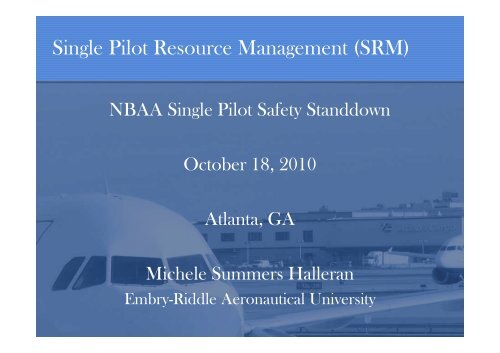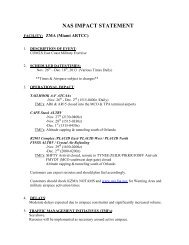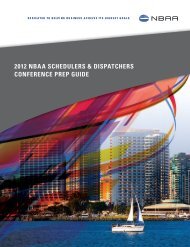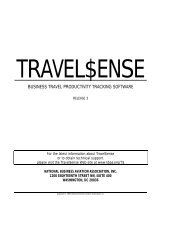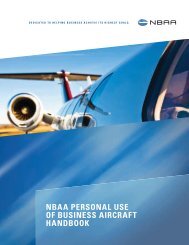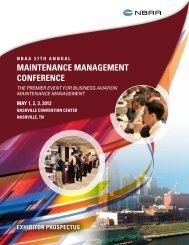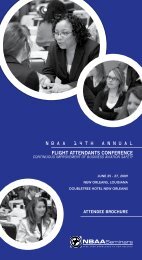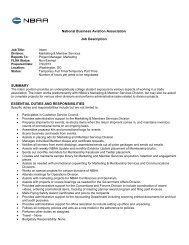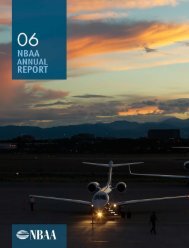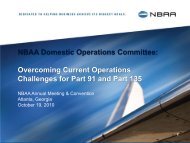Single Pilot Resource Management (SRM) - NBAA
Single Pilot Resource Management (SRM) - NBAA
Single Pilot Resource Management (SRM) - NBAA
Create successful ePaper yourself
Turn your PDF publications into a flip-book with our unique Google optimized e-Paper software.
<strong>Single</strong> <strong>Pilot</strong> <strong>Resource</strong> <strong>Management</strong> (<strong>SRM</strong>)<br />
<strong>NBAA</strong> <strong>Single</strong> <strong>Pilot</strong> Safety Standdown<br />
October 18, 2010<br />
Atlanta, GA<br />
Michele Summers Halleran<br />
Embry-Riddle Aeronautical University
<strong>SRM</strong> Perspective<br />
A 747 captain taxies the aircraft into the gate at SeaTac, finishes all of the<br />
paperwork, changes out of uniform, and drives to Boeing Field to an<br />
FBO to rent a C-172 for a little side trip to the San Juan Islands. He<br />
checks weather and prepares an IFR flight plan to Friday Harbor. He<br />
calls Flight Service and files the flight plan. When he gets to the Remarks<br />
section, he tells the briefer; "oh yes, remarks; put in there that I am<br />
declaring an emergency." The briefer is obviously taken aback by this, and<br />
says, "you want the remarks column in your flight plan to reflect that you<br />
are declaring an emergency?" "You bet", says the captain," I'm down to<br />
one engine, one pilot, one radio; in my line of work that is an<br />
emergency!”<br />
I guess critical decision making is all in where you come from...
<strong>Single</strong> <strong>Pilot</strong> <strong>Resource</strong> <strong>Management</strong> (<strong>SRM</strong>)<br />
• What is Crew <strong>Resource</strong> <strong>Management</strong> ?<br />
1. CRM: The effective utilization of all available<br />
human, informational, and equipment resources<br />
toward the goal of safe and efficient flight..<br />
2. More specifically, it is the active process employed<br />
by crewmembers to identify existing and potential<br />
threats and to develop, communicate, and<br />
implement plans and actions to avoid or mitigate<br />
perceived threats (Helmreich, 2000).
<strong>Single</strong> <strong>Pilot</strong> <strong>Resource</strong> <strong>Management</strong> (<strong>SRM</strong>)<br />
• What is <strong>Single</strong> <strong>Pilot</strong> <strong>Resource</strong> <strong>Management</strong> ?<br />
<strong>SRM</strong>: The art and science of managing all resources<br />
(both on-board the aircraft and from outside<br />
resources) available to a single-pilot (prior and during<br />
flight) to ensure the successful outcome of the flight<br />
is never in doubt.<br />
(FAA/Industry Training Standards)
<strong>Single</strong> <strong>Pilot</strong> <strong>Resource</strong> <strong>Management</strong> (<strong>SRM</strong>)<br />
• <strong>Single</strong> <strong>Pilot</strong> <strong>Resource</strong> <strong>Management</strong> is about the unique<br />
situations we find ourselves in as single pilot operators.<br />
• Follows the lead provided by the airline industry to<br />
improve flight safety through CRM training.<br />
• Human factors-related accidents motivated the airline<br />
industry to implement CRM training for flight crews.<br />
• Now, pilot error related accidents are motivating single<br />
pilot operators to implement <strong>SRM</strong> training.
Need for <strong>SRM</strong> Programs<br />
• 71-80% of all GA aircraft accidents can be directly<br />
attributed to human (pilot) error<br />
• What are the causes of human error ?<br />
• Can we completely eliminate human error ?<br />
• Through TRAINING ?<br />
• Through TECHNOLOGY/ENGINEERING ?
Need for <strong>SRM</strong> Programs?<br />
• <strong>Single</strong> <strong>Pilot</strong> vs. Dual <strong>Pilot</strong> Accidents<br />
• A single pilot operator has 1.6X greater probability of<br />
being involved in an accident (based on a 5yr average)<br />
• 2005 – 80% of multi-engine turboprop accidents<br />
involved single pilot ops<br />
•63% of all turboprop fleet is single piloted<br />
Information provided by Robert E. Breiling Associates
2009 AOPA Nall Report
2009 AOPA Nall Report
2009 AOPA Nall Report
<strong>Single</strong> <strong>Pilot</strong> <strong>Resource</strong> <strong>Management</strong> (<strong>SRM</strong>)<br />
1. Aeronautical Decision Making<br />
2. Automation <strong>Management</strong><br />
3. Task <strong>Management</strong><br />
4. Situational Awareness<br />
5. Risk <strong>Management</strong><br />
6. CFIT Avoidance
<strong>Single</strong> <strong>Pilot</strong> <strong>Resource</strong> <strong>Management</strong> (<strong>SRM</strong>)<br />
• The 5 P’s<br />
1. Plan<br />
2. Plane<br />
3. <strong>Pilot</strong><br />
4. Passengers<br />
5. Programming
The Decision Points<br />
• During flight planning phase<br />
• Before departure<br />
• Every half-hour or at regular intervals as<br />
appropriate<br />
• Before leaving cruise altitude<br />
• Before descent /approach/leaving IAF<br />
• Before landing
<strong>SRM</strong> Decision Process<br />
• At predetermined decision points consider the following:<br />
• What's the situation? The 5 P’s (Plan, Plane, <strong>Pilot</strong>, Passengers, and<br />
Programming)<br />
• What's changed since your original Go/No Go decision.<br />
• What negative outcomes are we more exposed to?<br />
• Engine failure<br />
• Avionics failure<br />
• Missed approach<br />
• <strong>Pilot</strong> overload<br />
• Mistakes on approach / final<br />
• CFIT<br />
• Fuel exhaustion<br />
• Icing<br />
• Loss of control
<strong>SRM</strong> Decision Process<br />
• What can we do to minimize the increased risk<br />
associated with those outcomes?<br />
• Use automation to reduce workload / increase awareness.<br />
• Use MFD to maintain terrain awareness, etc<br />
• Use passengers to share workload / monitor environment<br />
• Request<br />
• A simpler approach<br />
• <strong>Single</strong> frequency approach<br />
• Vectors to final<br />
• Declare minimum fuel<br />
• Ask for altitude / routing change<br />
• Turn down "difficult" ATC requests
<strong>SRM</strong> Decision Process<br />
• Prioritize tasks<br />
• If we can't do everything well, at least get the important<br />
things right.<br />
• What are they?<br />
• What can we "shed“<br />
• Is the resulting risk acceptable?<br />
• Would I have taken off knowing this was going to happen?<br />
• If not, divert / terminate the flight early
Sample <strong>SRM</strong> Scenario<br />
• Group Discussion of Real Time <strong>SRM</strong> Application<br />
• No “right answers”<br />
• Non attribution!!!<br />
• Apply the “5P” process to a basic flight situation<br />
• Prepare for the scenarios to follow!
Sample <strong>SRM</strong> Scenario<br />
St. Augustine, FL to Washington, D.C.
Pre Flight<br />
• St. Augustine, FL (KSGJ) to Washington, D.C. (KIAD)<br />
• Background Information<br />
• <strong>Pilot</strong>/Owner SR 22 (PFD/TKS/Datalink Weather/Traffic)<br />
• Leaving KSGJ Sunday afternoon with two business associates<br />
• One is a friend<br />
• One you've not met before<br />
• All three meeting at FAA HQ Monday Morning at 0900<br />
• VFR at SGJ, MVFR IAD, MVFR en route<br />
• GPS database is not current
Facilitators Notes<br />
The “5P” Check<br />
The Plan?<br />
Direct or airways<br />
Non Stop or two stop<br />
44 minute reserve, are we legal (FACILITATOR WILL ADD FUEL AS REQUESTED up to one hour))<br />
NIGHT/OVERWATER/IFR am I concerned??? (rule of three’s)<br />
The Plane?<br />
Maint status<br />
The <strong>Pilot</strong>?<br />
How early did I get up?<br />
How tired am I (IMSAFE)<br />
Recency/currency (go around the room – last weather approach,last IFR flight, last long in cloud flight, last night flight<br />
The Passengers?<br />
Pvt <strong>Pilot</strong>/Non <strong>Pilot</strong> (1 each)<br />
(seats)<br />
Duties, familiarity with IFR charts/Cirrus systems<br />
Urgency of trip (employment relationship)<br />
Give a safety disclaimer briefing) (we may have to stop/ short drive in)<br />
The Programming?<br />
Whats going out of date, charts or database (both)<br />
What do we need to fly (new charts/bad database)(how)
Pre Flight<br />
• St. Augustine, FL to Washington, D.C.<br />
• Weather Information<br />
• METAR for KSGJ 25 0000Z 27010KT 10SM CLR 12/7 A2995<br />
• TAF for KSGJ 251800Z 251818 2505KT 10SM FEW 0500<br />
• METAR for KIAD 25 0000Z 3105KT 3SM BKN 020 00/M14 A2990<br />
• TAF for KIAD 251800Z 251818 3305KT 3SM BKN 010<br />
• Area Forecast<br />
• Occasional light turbulence, negative icing, and improving ceilings and<br />
visibilities as the cold front moves south
<strong>SRM</strong> Quiz<br />
Pre Flight<br />
•5P’s<br />
•What are the risk factors?<br />
•What do we know that will help?<br />
•What don’t we know that may help?<br />
•What can we do to improve our situation?<br />
•Abort or Continue?
Pre-Takeoff<br />
• Engine shows 1 quart lower than you expected<br />
• A friend asks you to carry an additional 100 lbs of<br />
office equipment<br />
• Clearance delivery gives you an IFR ATC ground<br />
hold for 30 minutes<br />
• Passenger No 2 is quiet and makes several trips to<br />
the rest room but is very positive about the trip
Pre-Takeoff<br />
• 5P’s<br />
• What are the risk factors?<br />
• What do we know that will help?<br />
• What don’t we know that may help?<br />
• What can we do to improve our situation?<br />
• Abort or Continue?
Facilitators Notes<br />
•The “5P” Check<br />
The Plan?<br />
Delayed departure?<br />
Is the weather moving in?<br />
The Plane?<br />
Legal without the light?<br />
Time delay for the repair?<br />
The <strong>Pilot</strong>?<br />
How fresh will I be just after midnight EDT?<br />
The Passengers?<br />
Is one of them sick?<br />
The Programming?<br />
Manually verify the GPS database off the current charts<br />
GPS approaches not legal without a valid database
CHS – One Hour After Takeoff<br />
•In clear at 9000<br />
•FSS - SDZ Special Weather 500-2 at 2045Z<br />
•IAD 1500-3 at 2007Z<br />
•Oil Temp is down 3 degrees<br />
•Oil Pressure is up 2 lbs<br />
•Jacksonville Center directs a new routing direct<br />
--- --- flight planned route
Facilitators Notes<br />
•The “5P” Check<br />
The Plan?<br />
Fuel status<br />
WX update for IAD and enroute<br />
The Plane?<br />
Temp at 9000’? Icing or in the clear?<br />
The <strong>Pilot</strong>?<br />
Tired?<br />
The Passengers?<br />
Bathroom problem? Sick?<br />
The Programming?<br />
Entire route and approach into IAD?
SDZ – Two Hours After Takeoff<br />
• Groundspeed is down 10 knots from<br />
planned<br />
• ATC assigns new route clearance V373<br />
GSO V266 SBV Flight Planned Route<br />
• ATC requests an altitude change. Your<br />
choice of 7000’ or 11,000’. Temp at<br />
7000’ is 4 C and temp at 11,000’ is 1 C.<br />
What are the risks now?<br />
What are you going to do about it?
Facilitators Notes<br />
•The “5P” Check<br />
The Plan?<br />
Fuel issue, can we accept the new route altitude?<br />
In clouds or out at 7/11<br />
What are the winds at 7/11?<br />
Why the reroute……………if asked answer is a radar outage ahead at Wash Center<br />
(don’t volunteer this info)<br />
The Plane?<br />
11,000 feet ice (1 degree separation)<br />
7,000 ft (will ice be a factor by DC traveling north<br />
The <strong>Pilot</strong>?<br />
11,000 ft at dusk, hypoxia<br />
Oxygen rules vs night flight<br />
The Passengers?<br />
They will be quieter at 11,000!!!!<br />
The Programming?<br />
Technique, turn then program<br />
Use GPS/MFD to replan in the air
Over SBV<br />
• Washington Center reports a radar outage<br />
and asks you to report the next intersection<br />
• Back seat passenger asks “are we there yet?”<br />
• Oil Pressure up one more lb and temp<br />
down 2 degrees<br />
• You notice the autopilot is having more<br />
trouble maintaining wings level and is<br />
appears less stable in pitch<br />
• Becoming dark outside and you are in and<br />
out of the clouds<br />
Have the risks changed?<br />
Has your plan changed?
Facilitators Notes<br />
•The “5P” Check<br />
The Plan?<br />
Fuel status<br />
Does re-route increase distance/time?<br />
The Plane?<br />
Anti-icing equipment<br />
Legal requirement –known icing<br />
TKS<br />
How does the autopilt mask icing encounters<br />
The <strong>Pilot</strong>?<br />
Fatigued?<br />
Up to IFR/icing conditions single pilot?<br />
The Passengers?<br />
Figure out what to do about pax bathroom problem<br />
The Programming?<br />
Is re-route programmed and double checked?<br />
Use direct to to check options<br />
Alternate considerations?
Facilitators Notes<br />
•The “5P” Check
GVE – Start Descent<br />
• ATC advises to report FLUKY for resumption of<br />
ATC services<br />
• Front seat passenger says he feels tired and<br />
queasy<br />
• Back seat passenger is very quiet but asks<br />
several times if everything is OK<br />
• ATC requests reporting over Fluky for an<br />
approach into IAD<br />
• ATIS report active runway is 19L, expect vectors<br />
to the ILS and sequencing around heavy jet<br />
traffic.<br />
• After the altitude change, ice begins to form on<br />
the windshield.<br />
• Oil pressure is up 2 more lbs and oil temp is<br />
down 5 degrees
Facilitators Notes<br />
•The “5P” Check<br />
The Plan?<br />
Fuel status with re-route?<br />
ATIS-which approach is in use? WX minimums?<br />
Consider alternate?<br />
The Plane?<br />
Temp? Icing?<br />
The <strong>Pilot</strong>?<br />
Am I safe under these conditions?<br />
The Passengers?<br />
Is pax sick in the back?<br />
Do I reassure them, or fly the airplane?<br />
How can they help?<br />
The Programming?<br />
What do you plan to fly/routing/approach?<br />
What time is it, do I have to check the fixes in the GPS or just fly off the current paper charts
Over Fluky - IAF<br />
•ATC radar back in service<br />
•Cirrus NX 211 expect vectors to<br />
runway 19R, you are number four for<br />
the runway behind heavy jet traffic, what<br />
speed can you maintain on final?<br />
•Autopilot is very sloppy now and seems<br />
unable to maintain heading or altitude,<br />
airspeed has dropped 20 knots<br />
What is my physical and emotional state?<br />
Is it too late to change the plan?<br />
What are the risks now?
Facilitators Notes<br />
•The “5P” Check<br />
? The Plan?<br />
Your fuel reserve is below 30 minutes now<br />
Divert, minimum fuel, or emergency fuel<br />
The Plane?<br />
Think of descent temps/icing?<br />
The <strong>Pilot</strong>?<br />
Feel comfortable as single pilot in these WX conditions?<br />
Fatigued?<br />
Done all of your checklists?<br />
The Passengers?<br />
How can they help?<br />
How can you reassure them-keep them busy?<br />
Should you divert to Richmond and drive the rest of the way?<br />
The Programming?<br />
Hand fly the approach<br />
Have you thought of all alternatives with a runway change?<br />
Is there holding in progress until the runways open up? Fuel?<br />
Do you have a back up route programmed just in case<br />
Which is better, set the navaids then program the route or vice versa
On the Approach<br />
• ATC loses radar again<br />
• ATC assigns you a full VOR approach<br />
to another runway<br />
• After established outbound on the VOR<br />
approach, you recheck fuel<br />
• Passenger tells you they really need to<br />
use the bathroom<br />
• More ice on leading edge of wings<br />
• Do you declare an emergency?<br />
• Where do you land?
Facilitators Notes<br />
•The “5P” Check<br />
The Plan?<br />
Is it too late to divert to Richmond or another suitable airport?<br />
Fuel status<br />
Go to Manassas ASAP!<br />
The Plane?<br />
Icing? Is the anti-icing system working?<br />
The <strong>Pilot</strong>?<br />
Up to the challenge of a non-precision approach in solid IFR?<br />
Checklists done? How is your attention span?<br />
What are you focusing on?<br />
The Passengers?<br />
Is the other pax okay with diverting and driving into IAD?<br />
The Programming?<br />
For destination have two approaches programmed as a back up<br />
Able to have a clear depiction of WX conditions?<br />
Routing? NRST, Direct, ILS, no time to check the data base<br />
Backup route programming??
Facilitators Notes<br />
•The “5P” Check<br />
The Plan?<br />
This should lead to a discussion of minimums for manual recovery?<br />
Use of autopilot to recover?<br />
Use of the ballistic parachute?<br />
Do you have a pre-thought out plan?<br />
Does the chute cause you to take more risks?<br />
Not big ones just subtle ones<br />
The Plane?<br />
The <strong>Pilot</strong>?<br />
Which is more important, saving the plane or saving the pilot?<br />
Embarrassment, is it an issue?<br />
The Passengers?<br />
Did you brief them?<br />
On use of the parachute<br />
Identifying ground lights etc.<br />
The Programming?<br />
Not much to do here?
AC 120-51c States<br />
Good training for routine operations can have a strong<br />
positive effect on how well individuals function during times<br />
of high workload or high stress. During emergency situation,<br />
it is highly unlikely (and probably undesirable) that any<br />
crewmember [pilot] would take the time to reflect upon his<br />
or her CRM [<strong>SRM</strong>] training in order to choose the<br />
appropriate behavior. But practice of desirable behaviors<br />
during times of low stress increases the likelihood that<br />
emergencies will be handled effectively.<br />
<strong>Pilot</strong>s should make <strong>SRM</strong> procedures a regular part of every flight. A well<br />
practiced habit that can be relied upon in times of stress. Before <strong>SRM</strong> can<br />
become a habit, we have to learn it!!
Self Assessment<br />
• <strong>Pilot</strong>s operating as single pilots need to be able to<br />
critique their own performance.<br />
• Hard to do.<br />
• Several ways it can be done.<br />
- Take notes – keep a journal.<br />
- Assess the different situations that occurred.<br />
- What could have been done differently.<br />
- Use different scenarios.
Self Assessment<br />
• Analyze contributing factors:<br />
- Weather<br />
- Air Traffic Control<br />
- Aircraft<br />
- Workload<br />
- Flight conditions (VMC/IMC)
Assessment<br />
• Use all available resources to provide feedback<br />
- Passengers<br />
- Other pilots<br />
- Scenario based training (FITS/LOFT)<br />
• Determine improvement areas<br />
• Take measurements to improve these areas for<br />
future flights
Questions?


